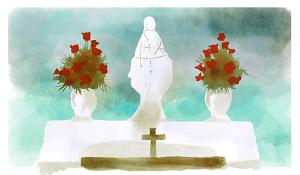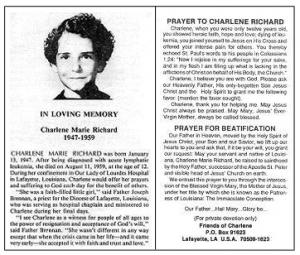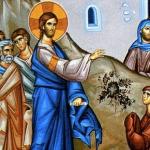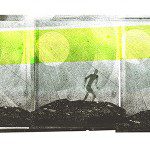
The sun shone starkly and the humidity hugged us unwelcomingly as my mom and I entered the graveyard. The August midday sun made the colors pop–the freshly mown grass was brightly green, the tombs, even the ancient and barren old ones, were dramatically white, and the newer graves were decorated with recently placed multi-colored flower bouquets. A recent tawny-hued stuffed rabbit toy was placed on a child-sized tomb, causing a fresh pang within me in this already sober place.
Richard, Louisiana, is barely a blip on any map. (Not pronounced like an English king, but the Cajun way: Ree-shard.) The graveyard is probably the most frequented place in this small town with no traffic lights or McDonald’s. Church Point is huge by comparison, and their most prestigious entity is also the town’s cultural center–a Sonic Drive-in.
I love us Cajuns.
I can remember my grandma laughing at my silly frustration when I complained how small the local Cajun communities, including my hometown, were. My 10-year-old self reasoned that it’d be much better if our family lived in California, the dream home of most little kids. She gave me a piece of grandmotherly advice that also shut me up: To make my ugly beliefs meaningless, I had to say what I wish were true as a simple statement, as if it were reality. If I simply repeated this fact, it would leave me no reason to complain.
So I made a mantra for myself: My small town is great. My small town is great.
***
My sister’s fat and overexcited golden retriever jumped onto my mom in late March, causing her to feel pain in her stomach. She went to her doctor to find out if she was suffering from a hernia. She returned with a diagnosis of pancreatic cancer. The good news is that because of a goofy and hyperactive dog, the cancer was discovered at an early stage – the earliest, the doctor mentioned, that she’d ever seen.
The bad news, of course, is that my mom was diagnosed with cancer.
During one of my mom’s first chemo. treatments, she was given a prayer cloth and a prayer card with the story of Charlene Richard, “the Cajun Saint.” Charlene was a bright but unremarkable preteen girl from a small town in Louisiana. She was religious, but no more than most born into a Cajun family in the ‘40s. After a teacher was concerned because Charlene reported a tall woman in black who would evanesce quickly, her parents brought her to a doctor who diagnosed her with leukemia. She had a painful and rapid decline. Saint Thérèse of Lisieux’s book on prayer was influential to her; Charlene wanted more than anything to become a saint.
Charlene offered up her suffering to God, not complaining about the excruciating pain she was in. Instead, she petitioned to suffer on behalf of those with illnesses and to convert people to Catholicism. The chaplain of the hospital, a newly ordained priest, was so struck by the sincere faith of this child that he visited Charlene daily.
After Charlene spent over a month in the hospital, her parents were given the devastating news that their 12-year-old daughter would die, and soon. Rather than keep this information from her, her parents and the hospital chaplain gave her the doctor’s diagnosis directly. Upon hearing the news, the little girl seemed remarkably unfazed; she remained steadfast in her prayers for others’ healings and conversions.
Since her death, many people have attributed divine and miraculous healings to her intercession. She has not been officially canonized by the Roman Catholic Church, but in the ‘90’s the Vatican started seeking any miraculous interventions attributed to her intercession. I don’t know if it’s slow-moving or appropriate that the case hasn’t progressed since then. Regardless, local bishops celebrate the anniversary of her death and Catholics in the area know her as the “Cajun Saint.”
“When I die… I will spend my heaven by doing good on earth.” ― Thérèse de Lisieux
I wonder if the Cajun Saint kept repeating that phrase from Saint Thérèse, making it her personal mantra, until it came true.
***
There is a black wire bench, a small kneeler from a church, and a black locked mailbox labelled “Petitions” around the grave of Charlene Richard. Her small white tomb is the lower-left corner of a square of her family’s graves, with her brother’s grave on the right, and her parents’ behind her.
As my mom sat on the bench, her short golden hair almost glittery in the August sunlight, I read a laminated sheet tied onto the grave, dated 2017. It was typed by the father of a 19-year-old college student who came to Charlene’s grave to pray after she was diagnosed with stage-4 cancer. According to that letter, the man “saw” “power” flow into his daughter’s hand after she traced the name of Charlene Richard engraved on the tomb.
As to be expected from a laminated letter attached to a known miracle worker’s gravesite, the daughter was then completely healed of her stage-4 cancer. Her father noticed immediately how color seemed to flow back to her cheeks and her skinny, fragile body seemed to be rejuvenated with strong limbs and to be overall refreshed. The daughter today lives in Texas with her husband, and is mother to four children.
Praise the Lord, right?
“Miracles do happen,” the letter concluded. “I witnessed one with my own eyes.” Then in all caps and in a large font: “GOD BLESS AMERICA.”
***
Alone in the shadeless graveyard, my mom and I finished our quiet prayer-time, she on the bench next to Charlene’s grave and I in my wheelchair, resting the laminated letter back on its string so the next pilgrim may read it and be touched by its message. On the way back to our vehicle, my mom asked if I remembered that I told her that I thought God asked me to suffer for him when I was conceived.
I visibly cringed and felt a sickening knot in my stomach. I remembered it well — my religion teacher in Catholic high school showed us a video of a woman who had died and then was brought back to life –speaking of having seen Heaven, Hell, and Purgatory, with Jesus as her guide. One piece of knowledge she shared in the video was that at the moment of their conception, people with genetic anomalies are asked by Jesus if they will suffer for him.
“What?” my mom asked, noticing my obvious look of embarrassment. “Don’t you believe that anymore?”
“I don’t know,” I confessed, honestly. “I think that back in high school I was eager to believe anything that made me out to be a hero.”
“Oh,” she said, trying to mask what she was thinking. But that never worked between us two. I could sense a little disappointment as she said, “Well, I think that if you did, I said I’d suffer too. There’s nothing harder than being a parent and watching your kids suffer with a disability.”
Both of my mom’s dogs waiting for us in the van eagerly greeted us as we returned from our time in the graveyard. I thought a lot about paradoxes – that a woman with cancer and her son in a wheelchair were visiting the grave of a little girl who died of leukemia believing that she suffered on others’ behalf. And I wondered what God was thinking, looking down on this picturesque scene; the parent of us both, who, if he did, suffered for us in silence.
As we drove away, my mom pointed out how little the carved portrait resembled Charlene. I looked – what I assumed was a sculpture of the Pieta was actually a flat rock with a carved picture of a hazy, unremarkable, and unrecognizable girl.
It’s tempting to mock this, but this is what I believe in — a Church of contradictions, where the sick petition the dead to ask the living God for a healing. A Church filled with reminders of salvific life, no matter how rudimentary or cheesy.
My mom told me she tries to go visit the grave once a week. I asked if I could go with her from now on.
“For me, prayer is a surge of the heart; it is a simple look turned toward heaven, it is a cry of recognition and of love, embracing both trial and joy.” ― Thérèse de Lisieux
This is what I believe.
This is what I believe.













